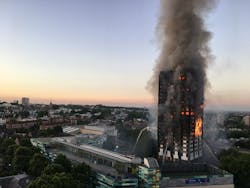FHWorld18: London Fire Official Details the Grenfell Fire Tragedy
On June 14, 2017, the Grenfell Tower fire claimed the lives of 71 civilians in London—the country’s deadliest fire since World War II. Speaking at a Firehouse World special educational session about the tragedy, London Fire Brigade (LFB) Assistant Commissioner Graham Ellis discussed the department’s response to what he described as an “unprecedented event” that sent shock waves through the LFB and the entire city.
Ellis acknowledged early in the presentation, which was sponsored by American Military University, that there are many details of the event that he is currently not at liberty to share due to the ongoing coronial investigation, the Metropolitan Police criminal investigation, and an independent public inquiry that was called for by the prime minister. He emphasized that it’s important to support the investigations to ensure that the victims and their families receive justice, but also assured that the department is eager to share all the messages it can as quickly as possible so people have a full understanding of the event.
Setting the stage
Ellis set the stage for the Grenfell Tower fire, describing in detail the building itself—a 24-story building with approximately 129 apartments housing up to 600 residents—located in an area of the city that is deeply divided in terms of economic prosperity. The tower was built in the early 1970s during a time of massive population growth and had one small concrete staircase in the center of the structure, which was common at the time. He noted that the temperatures within that staircase during the fire were “phenomenal,” as evidenced by the melted bulkhead lights.
To update its rather dated-looking façade, the building underwent a refurbishment only a few years before the fire. Part of the refurbishment involved a new cladding system that would ultimately become a key factor in the fire’s behavior on the night of the blaze. Further, the building did not include a sprinkler system.
Fast-moving fire
Firefighters were called to a fire that started in a fridge freezer on the fourth floor. Crews extinguished the fire, and as they were exiting the building, there was a spike in 9-9-9 calls (equivalent of 9-1-1). The fire had somehow spread and was now racing up the exterior cladding.
Ellis explained that it was a particularly warm and mucky night in London, which could have contributed to the fire spread, as residents would have likely had their windows open; essentially, a fire that started inside the building could transfer to the exterior cladding through the windows.
With the fire’s rapid spread, some residents crammed into the single stairwell to flee the structure while others followed the “Stay Put” policy, which is normally encouraged during a high-rise fire, Ellis said; however, this fire moved fast and blew through apartments in an extraordinary fashion.
More than 200 firefighters and officers responded to the scene, along with 40 pumping appliances, seven command units to coordinate response, 14 fire-rescue units, four aerial appliances, and 50 urban search-and-rescue units. Sixty-five residents were rescued by firefighters, who made repeated attempts to save lives, Ellis said, even breaking procedure during the unprecedented event. There were dozens of firefighter injuries but no firefighter fatalities. “I still cannot believe we didn’t lose one firefighter,” he said, reflecting on how dangerous the incident was for all involved.
The incident ultimately lasted 13 days, and the LFB fire investigation and fire engineering teams are still on scene assisting with investigations.
The aftermath
Beyond physical injuries, Ellis explained, the LFB began working to address the potential psychological issues associated with responding to a tragedy of this nature. The department implemented a Psychological Support Plan that involves multiples stages, from the immediate shift through a 28-day follow-up. High levels of stress have been identified in those who responded to the call as well as those who were answering the dispatch calls throughout the incident, he said, adding that, “People who attended the fire that night will never, ever be the same—and those who weren’t there need to understand that.”
Ellis noted that London Fire Brigade Commissioner Dany Cotton showed true leadership on this issue when she shared that she had sought counseling after the incident, underscoring that “it’s all right to not feel all right, and it’s all right to ask for help,” he said.
Ellis addressed other factors from the aftermath of the tragedy, including the importance of ensuring a dignified system for providing information to the families of the deceased. This part of the process also underscored the importance of having strong relationships with other fire departments, even international ones. For example, knowing what the FDNY had experienced post 9/11, the LFB reached out to cohorts in New York for guidance about the best approach for handling such a large-scale recovery effort.
When it comes to working with politicians and other “VIPs” who reach out after tragedies of this nature, Ellis shared a story that underscored the importance of speaking up to those in power who can affect change. While surveying the building with a politician, he had expressed frustration about how much firefighters are expected to manage—and later second-guessed himself for speaking up. But that politician has since proven to be an ally of the department, and Ellis no longer questions his decision to speak his truth in that moment.
What went wrong
During the presentation, Ellis showed a video in which the exterior cladding was described in great detail, including the fact that part of the cladding is made up of aluminum sheets with a polyethylene core that burns at extreme temperatures. In the United States, most jurisdictions ban this type of cladding for high rises, and the International Building Code requires cladding for tall buildings to pass a rigorous test developed by the National Fire Protection Association (Standard 285). Media reports focus on this factor in the tragedy, and building materials have since become a lynchpin in the discussion.
With regard to safety tests, Ellis shared that police are working with experts to review every element of the construction of Grenfell Tower, including the aluminum composite tiles, the insulation behind it, how the tiles were fixed to the building and how it was installed. Preliminary tests show that the insulation samples collected from the tower combusted soon after the test commenced, and the initial tests on equivalent aluminum composite tiles failed the safety tests. Further, these test results were immediately shared with the Department of Communities and Local Government, who are sharing that information with local councils throughout the country.
Moving forward
Ellis reiterated that there is much work ahead and more information to follow related to the Grenfell Tower fire. There will certainly be expanded discussions on building construction and materials, firefighter safety, fire prevention efforts, the “Stay Put” policy and more. Ellis concluded by expressing his desire to share the full story with attendees at a future date, when he is not restricted by the current investigations.
The Grenfell Tower will be demolished.
About the Author

Janelle Foskett
Janelle Foskett served as editorial director of Firehouse Magazine and Firehouse.com, overseeing the editorial operations for the print edition along with working closely with the Web team.
